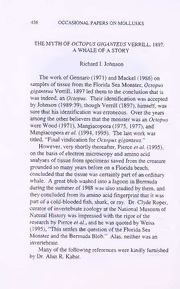
The myth of Octopus giganteus Verrill, 1897: A whale of a story PDF
Preview The myth of Octopus giganteus Verrill, 1897: A whale of a story
456 OCCASIONALPAPERS ON MOLLUSKS THE MYTH OF OCTOPUS GIGANTEUS VERRLLL, 1897; A WHALE OF A STORY Richard L Johnson The work ofGennaro (1971) and Mackel (1986) on samples oftissue from the Florida Sea Monster, Octopus giganteus Verrill, 1897 led them to the conclusion that is was indeed, an Octopus. Their identification was accepted by Johnson (1989:39), though Verrill (1897), himself, was sure that his identification was erroneous. Over the years among the other believers that the monster was an Octopus were Wood (1971), Mangiacopora (1975, 1977), and Mangiacopora et al. (1994, 1995). The last work was titled, "Final vindication for Octopus giganteus.'' However, very shortly thereafter. Pierce et al. (1995), on the basis ofelectron microscopy and amino acid analyses oftissue from specimens saved from the creature grounded so many years before on a Florida beach, concluded that the tissue was certainly part of an ordinary A whale. great blob washed into a lagoon in Bermuda during the summer of 1988 was also studied by them, and they concluded from its amino acid fingerprint that it was part ofa cold-blooded fish, shark, or ray. Dr. Clyde Roper, curator of invertebrate zoology at the National Museum of Natural History was impressed with the rigor ofthe research by Pierce et al., and he was quoted by Weiss (1995), "This settles the question ofthe Florida Sea Monster and the Bermuda Blob." Alas, neither was an invertebrate. Many ofthe following references were kindly furnished by Dr. Alan R. Kabat. OCCASIONAL PAPERS ONMOLLUSKS 457 LITERATURE CITED Gennaro, Jr., J.F. 1971. An Octopus Trilogy. Part2 The Creature Revealed. Natural History. The Journal ofthe American Museum ofNatural History. 80(3): 24,84,85 (March). Johnson, R.I. 1989. Molluscan taxaofAddisionEmery Verrill and Katherine Jeannette Bush, including those introduced by Sanderson Smith and Alpheus HyattVerrill. Occasional Papers on MoUusks 5(67): 1-143, pis. 1-19 (August). Mackel, R.P. 1986. Biochemical analysis ofpreserved Octopus giganteus tissue. Cryptozoology 5:55-62. Mangiacopra, G.S. 1975. Octopusgiganteus Verrill: a newspecies of Cephalopod. OfSeaand Shore 6(1): 3-10, 51 (Spring). 1977. More on Octopusgiganteus. OfSeaand Shore8(30): 174, 178 (Fall). Mangiacopra, G.S., M.P.R. Raynal, D.G. Smith and D.F. Avery. 1994. Update on Octopusgiganteus Verrill PartI: More forgotten fragments ofits 19th century history. OfSeaand Shore 17(4): 171-178, 9 figs. (Fall). 1995. Historyrepeating itself: PartII: Ignored-rediscovered- ignored again!-and final vindication for Octopusgiganteus 1909- 1994. OfSea and Shore 17(4): 221-225 (Winter). Pierce, S.K., G.N. Smith, Jr., T.K. Maugel and E.Clark. 1995. On the giantoctopus (Octopusgiganteus) and the BermudaBlob: Homage to A.E. Verrill. Biological Bulletin 188: 219-230 (April). Verrill, A.E. 1897. A gigantic Cephalopod on the FloridaCoast. American Journal ofScience (4)3:79 (January); Additional information concerning the giantCephalopod ofFlorida, Ibid. 162- 163 (February); The supposed greatOctopus ofFlorida; certainly not aCephalopod, Ibid. 355-356 (April) Weiss, R. 1995. Scientists sinka seamonstertale. Masses offlesh didn'tcome from acolossal Octopus, study concludes. The Washington Post, p. A18 (Sunday, April 2). Wood, E.G. 1971. An OctopusTriology. PartI Stupefying colossus of the deep. Natural History. The Journal ofthe AmericanMuseum ofNatural History 80(3): 14-16, 18, 20-24. PartIII In which Bahamian fishermanrecounttheiradventures with the beast. Ibid 84, 86, 87 (March).
